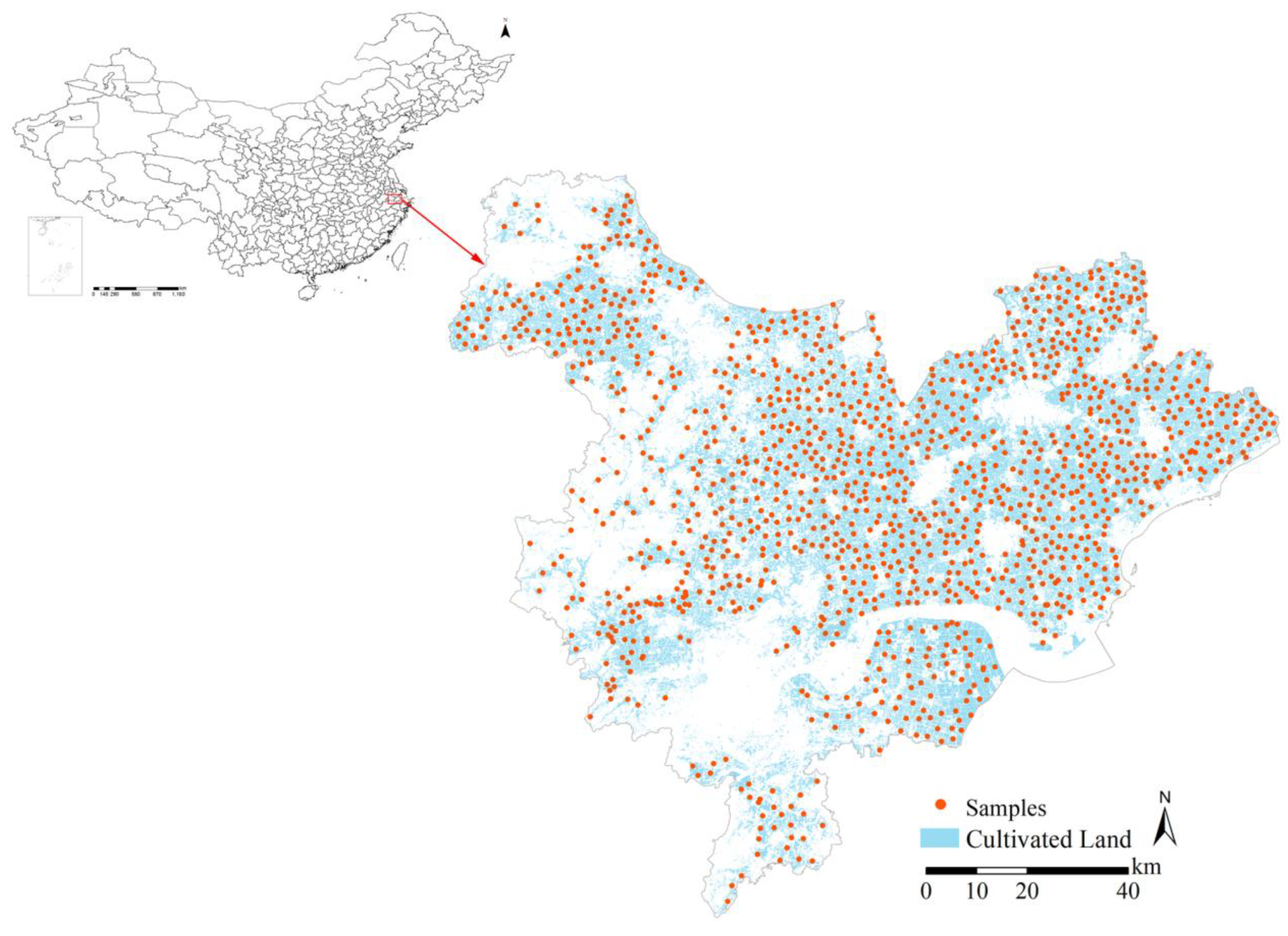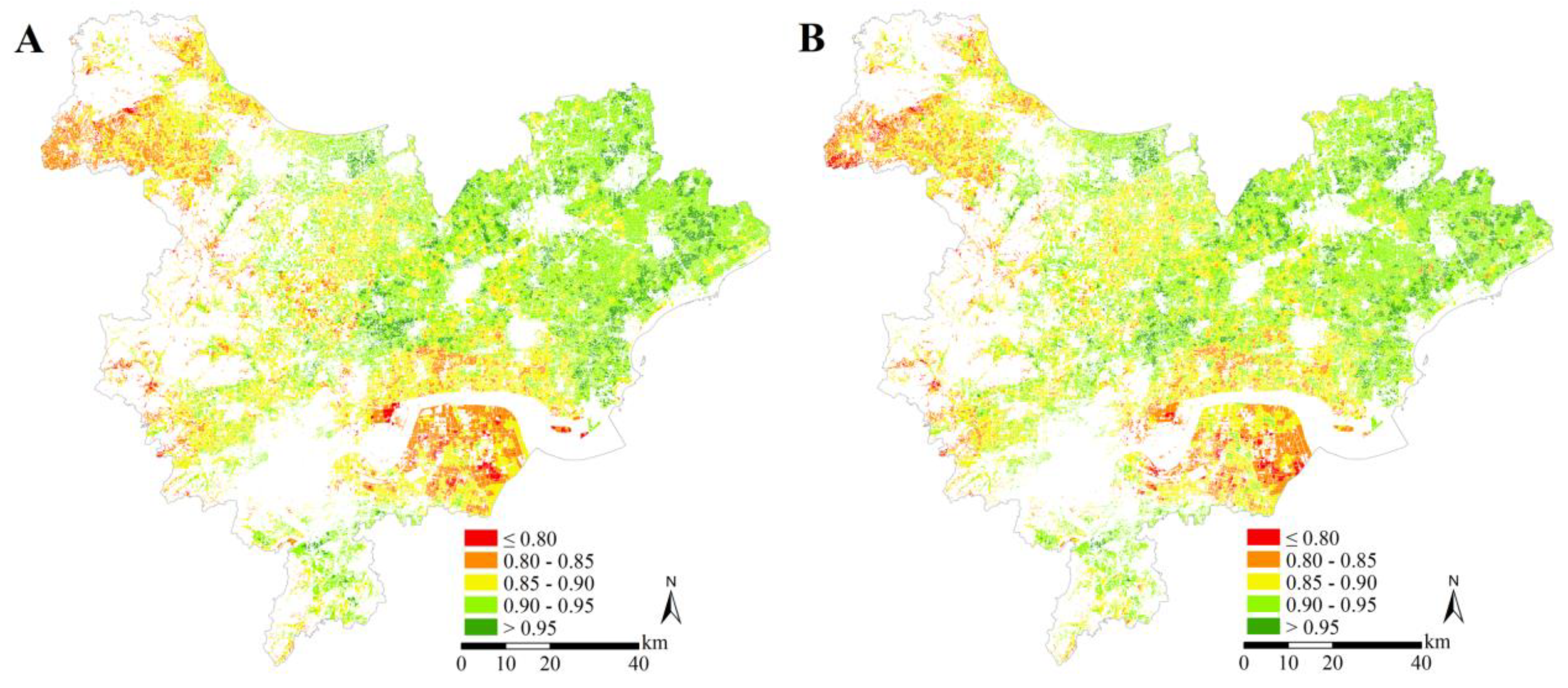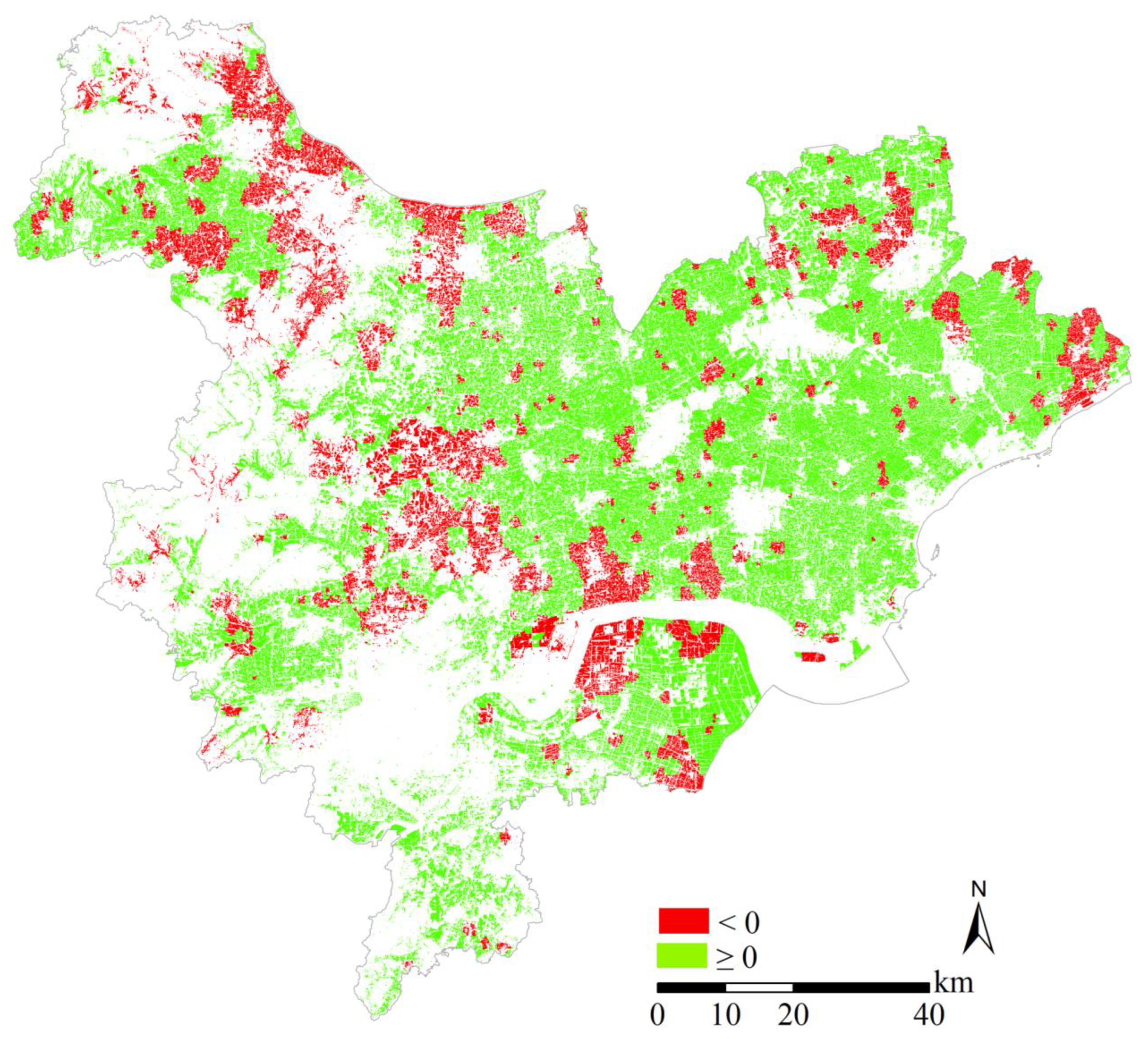Exploring the Spatial–Temporal Variation in Cultivated Land Quality and Influential Factors in the Lower Reaches of the Yangtze River from 2017 to 2020
Abstract
1. Introduction
2. Materials and Methods
2.1. Sampling and Chemical Analysis
2.2. Cultivated Land Quality Assessment
2.3. Influential Factor Selection and Processing
2.4. Factor Detection
3. Results and Discussion
3.1. Descriptive Statistics of Soil Properties and Cultivated Land Quality
3.2. Spatial–Temporal Variation in Cultivated Land Quality
3.3. Detection of Factors Affecting Cultivated Land Quality Changes
4. Conclusions
Author Contributions
Funding
Institutional Review Board Statement
Informed Consent Statement
Data Availability Statement
Conflicts of Interest
References
- Foley, J.A.; Ramankutty, N.; Brauman, K.A.; Cassidy, E.S.; Gerber, J.S.; Johnston, M.; Mueller, N.D.; O’Connell, C.; Ray, D.K.; West, P.C. Solutions for a cultivated planet. Nature 2011, 478, 337–342. [Google Scholar] [CrossRef] [PubMed]
- Tan, Y.; Chen, H.; Lian, K.; Yu, Z. Comprehensive evaluation of cultivated land quality at county scale: A case study of Shengzhou, Zhejiang Province, China. Int. J. Env. Res. Pub. He. 2020, 17, 1169. [Google Scholar] [CrossRef] [PubMed]
- Yang, X. China’s rapid urbanization. Science 2013, 342, 310. [Google Scholar] [CrossRef] [PubMed]
- Kuang, W.; Liu, J.; Dong, J.; Chi, W.; Zhang, C. The rapid and massive urban and industrial land expansions in China between 1990 and 2010: A CLUD-based analysis of their trajectories, patterns, and drivers. Landsc. Urban Plan. 2016, 145, 21–33. [Google Scholar] [CrossRef]
- Li, T.; Long, H.; Zhang, Y.; Tu, S.; Ge, D.; Li, Y.; Hu, B. Analysis of the spatial mismatch of grain production and farmland resources in China based on the potential crop rotation system. Land Use Policy 2017, 60, 26–36. [Google Scholar] [CrossRef]
- Zhao, R.; Wu, K.; Zhang, X. Evaluation of Farmland Health Productivity in Main Grain Producing Areas: A Case Study in Wen County of Henan Province. China Land Sci. 2019, 33, 67–75. [Google Scholar]
- Sheng, Y.; Liu, W.; Xu, H.; Gao, X. The Spatial Distribution Characteristics of the Cultivated Land Quality in the Diluvial Fan Terrain of the Arid Region: A Case Study of Jimsar County, Xinjiang, China. Land 2021, 10, 896. [Google Scholar] [CrossRef]
- Shen, R.; Wang, C.; Sun, B. Soil Related Scientific and Technological Problems in Implementing Strategy of “Storing Grain in Land and Technology”. Bull. Chin. Acad. Sci. 2018, 33, 135–144. [Google Scholar]
- Zhao, C.; Zhou, Y.; Jiang, J.; Xiao, P.; Wu, H. Spatial characteristics of cultivated land quality accounting for ecological environmental condition: A case study in hilly area of northern Hubei province, China. Sci. Total Environ. 2021, 774, 145765. [Google Scholar] [CrossRef]
- Liu, L.; Zhou, D.; Chang, X.; Lin, Z. A new grading system for evaluating China’s cultivated land quality. Land Degrad. Dev. 2020, 31, 1482–1501. [Google Scholar] [CrossRef]
- Nael, M.; Khademi, H.; Hajabbasi, M.A. Response of soil quality indicators and their spatial variability to land degradation in central Iran. Appl. Soil Ecol. 2004, 27, 221–232. [Google Scholar] [CrossRef]
- Kiani, M.; Hernandez-Ramirez, G.; Quideau, S.A.M. Spatial variation of soil quality indicators as a function of land use and topography. Can. J. Soil Sci. 2020, 100, 463–478. [Google Scholar] [CrossRef]
- Fei, X.; Xiao, R.; Christakos, G.; Langousis, A.; Ren, Z.; Tian, Y.; Lv, X. Comprehensive assessment and source apportionment of heavy metals in Shanghai agricultural soils with different fertility levels. Ecol. Indicat. 2019, 106, 105508. [Google Scholar] [CrossRef]
- Yang, Y.; Christakos, G.; Guo, M.; Xiao, L.; Huang, W. Space-time quantitative source apportionment of soil heavy metal concentration increments. Environ. Pollut. 2017, 223, 560–566. [Google Scholar] [CrossRef]
- Huang, S.; Tu, J.; Jin, Y.; Hua, M.; Wu, X.; Xu, W.W.; Yang, Y.; Wang, H.; Su, Y.; Cai, L. Contamination assessment and source identification of heavy metals in River Sediments in Nantong, Eastern China. Int. J. Environ. Res. 2018, 12, 373–389. [Google Scholar] [CrossRef]
- Ren, Z.; Christakos, G.; Lou, Z.; Xu, H.; Lv, X.; Fei, X. Contamination Assessment and Source Apportionment of Metals and Metalloids Pollution in Agricultural Soil: A Comparison of the APCA-MLR and APCA-GWR Models. Sustainability 2022, 14, 783. [Google Scholar] [CrossRef]
- Akinyemi, F.O.; Speranza, C.I. Agricultural landscape change impact on the quality of land: An African continent-wide assessment in gained and displaced agricultural lands. Int. J. Appl. Earth. Obs. 2022, 106, 102644. [Google Scholar] [CrossRef]
- Yuan, X.; Shao, Y.; Wei, X.; Hou, R.; Ying, Y.; Zhao, Y. Study on the potential of cultivated land quality improvement based on a geological detector. Geol J. 2018, 53, 387–397. [Google Scholar] [CrossRef]
- Wang, J.; Li, X.; Christakos, G.; Liao, Y.; Zhang, T.; Gu, X.; Zheng, X. Geographical detectors-based health risk assessment and its application in the neural tube defects study of the Heshun Region, China. Int. J. Geogr. Inf. Sci. 2010, 24, 107–127. [Google Scholar] [CrossRef]
- Cao, F.; Ge, Y.; Wang, J. Optimal discretization for geographical detectors-based risk assessment. Gisci. Remote Sens. 2013, 50, 78–92. [Google Scholar] [CrossRef]
- Qiao, P.; Yang, S.; Lei, M.; Chen, T.; Dong, N. Quantitative analysis of the factors influencing spatial distribution of soil heavy metals based on geographical detector. Sci. Total Environ. 2019, 664, 392–413. [Google Scholar] [CrossRef]
- Ren, Y.; Lin, M.; Liu, Q.; Zhang, Z.; Fei, X.; Xiao, R.; Lv, X. Contamination assessment, health risk evaluation, and source identification of heavy metals in the soil-rice system of typical agricultural regions on the southeast coast of China. Environ. Sci. Pollut. R. 2021, 28, 12870–12880. [Google Scholar] [CrossRef] [PubMed]
- Fei, X.; Lou, Z.; Xiao, R.; Ren, Z.; Lv, X. Estimating the spatial distribution of soil available trace elements by combining auxiliary soil property data through the Bayesian maximum entropy technique. Stoch. Environ. Res. Risk Assess. 2022, 36, 2015–2026. [Google Scholar] [CrossRef]
- Olea, R.A. A six-step practical approach to semivariogram modeling. Stoch. Environ. Res. Risk Assess. 2006, 20, 307–318. [Google Scholar] [CrossRef]
- Zhuo, Z.; Xing, A.; Li, Y.; Huang, Y.; Nie, C. Spatio-temporal variability and the factors influencing soil-available heavy metal micronutrients in different agricultural sub-catchments. Sustainability 2019, 11, 5912. [Google Scholar] [CrossRef]
- Liu, H.; Zhang, Y.; Zhou, X.; You, X.; Shi, Y.; Xu, J. Source identification and spatial distribution of heavy metals in tobacco growing soils in Shandong province of China with multivariate and geostatistical analysis. Environ. Sci. Pollut. R. 2017, 24, 5964–5975. [Google Scholar] [CrossRef] [PubMed]
- Lv, X.; Ni, Z. Soil Resources and Cultivated Land Quality Atlas of Zhejiang; Harbin Map Press: Harbin, China, 2013. [Google Scholar]
- Khan, J.; Singh, R.; Upreti, P.; Yadav, R.K. Geo-statistical assessment of soil quality and identification of Heavy metal contamination using Integrated GIS and Multivariate statistical analysis in Industrial region of Western India. Environ. Technol. Innov. 2022, 28, 102646. [Google Scholar] [CrossRef]
- Wang, J.; Xu, C. Geodetector: Principle and prospective. Acta Geograph. Sin. 2017, 1, 116–134. [Google Scholar]
- Wang, H.; Gao, J.; Hou, W. Quantitative attribution analysis of soil erosion in different geomorphological types in karst areas: Based on the geodetector method. J. Geogr. Sci. 2019, 29, 271–286. [Google Scholar] [CrossRef]
- Xiao, R.; Liu, Y.; Fei, X.; Yu, W.; Zhang, Z.; Meng, Q. Ecosystem health assessment: A comprehensive and detailed analysis of the case study in coastal metropolitan region, eastern China. Ecol. Indicat. 2019, 98, 363–376. [Google Scholar] [CrossRef]
- Fei, X.; Lou, Z.; Xiao, R.; Ren, Z.; Lv, X. Source analysis and source-oriented risk assessment of heavy metal pollution in agricultural soils of different cultivated land qualities. J. Clean. Prod. 2022, 341, 130942. [Google Scholar] [CrossRef]
- Cultivated Land Quality Monitoring and Protection Center, Ministry of Agriculture and Rural Affairs, PRC. Changsanjiao Gengdi Zhiliang Pingjia; China Agriculture Press: Beijing, China, 2018. [Google Scholar]
- Zhang, L.; Zhou, L.; Wei, J.; Cheng, X.; Xu, H.; Xiao, Z.; Tang, Q.; Tang, J. Effects of rice planting combined with chicken raising in winter on double-cropping rice growth and soil fertility. Chin. J. Rice Sci. 2018, 32, 226–236. [Google Scholar]
- Liu, J.; Shu, A.; Song, W.; Shi, W.; Li, M.; Zhang, W.; Li, Z.; Liu, G.; Yuan, F.; Zhang, S.; et al. Long-term organic fertilizer substitution increases rice yield by improving soil properties and regulating soil bacteria. Geoderma 2021, 404, 115287. [Google Scholar] [CrossRef]
- Liqun, X.; Wei, C.; Qun, W. Impact of cultivated land quantity change on grain productive capacity of Yangtze River delta in the next 10 years: From the perspective of cultivated land quality grade. J. Nat. Resour. 2012, 27, 565–576. [Google Scholar]
- Li, X.; Yu, M.; Ma, J.; Luo, Z.; Chen, F.; Yang, Y. Identifying the relationship between soil properties and rice growth for improving consolidated land in the Yangtze River Delta, China. Sustainability 2018, 10, 3072. [Google Scholar] [CrossRef]
- Su, S.; Jiang, Z.; Zhang, Q.; Zhang, Y. Transformation of agricultural landscapes under rapid urbanization: A threat to sustainability in Hang-Jia-Hu region, China. Appl. Geogr. 2011, 31, 439–449. [Google Scholar] [CrossRef]
- Song, J.; Cai, D.; Deng, J.; Wang, K.; Shen, Z. Dynamics of paddy field patterns in response to urbanization: A case study of the Hang-Jia-Hu Plain. Sustainability 2015, 7, 13813–13835. [Google Scholar] [CrossRef]
- Zhang, M.; Du, H.; Zhou, G.; Li, X.; Mao, F.; Dong, L. Estimating forest aboveground carbon storage in Hang-Jia-Hu using landsat TM/OLI data and random forest model. Forests 2019, 10, 1004. [Google Scholar] [CrossRef]
- Filep, T.; Draskovits, E.; Szabó, J.; Koós, S.; László, P.; Szalai, Z. The dissolved organic matter as a potential soil quality indicator in arable soils of Hungary. Environ. Monit. Assess. 2015, 187, 479. [Google Scholar] [CrossRef]
- Sequeira, C.H.; Alley, M.M. Soil organic matter fractions as indices of soil quality changes. Soil Sci. Soc. Am. J. 2011, 75, 1766–1773. [Google Scholar] [CrossRef]
- Pulido-Moncada, M.; Lozano, Z.; Delgado, M.; Dumon, M.; Van Ranst, E.; Lobo, D.; Gabriels, D.; Cornelis, W.M. Using soil organic matter fractions as indicators of soil physical quality. Soil Use Manag. 2018, 34, 187–196. [Google Scholar] [CrossRef]
- Malhotra, H.; Sharma, S.; Pandey, R. Phosphorus nutrition: Plant growth in response to deficiency and excess. In Plant Nutrients and Abiotic Stress Tolerance; Hasanuzzaman, M., Fujita, M., Oku, H., Nahar, K., Hawrylak-Nowak, B., Eds.; Springer: Berlin/Heidelberg, Germany, 2018. [Google Scholar]
- Zörb, C.; Senbayram, M.; Peiter, E. Potassium in agriculture—Status and perspectives. J. Plant Physiol. 2014, 171, 656–669. [Google Scholar] [CrossRef]
- Morgan, J.B.; Connolly, E.L. Plant-soil interactions: Nutrient uptake learn science at scitable. Nat. Educ. Knowl. 2013, 4, 2. [Google Scholar]
- Filip, Z. International approach to assessing soil quality by ecologically-related biological parameters. Agric. Ecosyst. Environ. 2002, 88, 169–174. [Google Scholar] [CrossRef]
- Qiao, Y.; Wang, X.; Han, Z.; Tian, M.; Wang, Q.; Wu, H.; Liu, F. Geodetector based identification of influencing factors on spatial distribution patterns of heavy metals in soil: A case in the upper reaches of the Yangtze River, China. Appl. Geochem. 2022, 146, 105459. [Google Scholar] [CrossRef]




| Categories | Factors | Abbreviations |
|---|---|---|
| Climate | Annual average precipitation | AAP |
| Annual average temperature | AAT | |
| Topography | Elevation | EL |
| Slope | SL | |
| Land use and land cover | LULC | |
| Soil properties | Soil type | ST |
| Soil texture | STE | |
| Soil parent material | SPM | |
| pH variation | pHV | |
| Soil organic matter variation | SOMV | |
| Soil available phosphorus variation | APV | |
| Soil available potassium variation | AKV | |
| Socioeconomic | Gross domestic product per capita | GDP |
| Primary industry output | PIO | |
| Second industry output | SIO | |
| Tertiary industry output | TIO |
| 2017 | 2020 | P a | Optimum Level b | |||
|---|---|---|---|---|---|---|
| Mean | Range (S.D.) | Mean | Range (S.D.) | |||
| pH | 6.32 | 4.21–9.16 (0.77) | 6.38 | 4.45–8.65 (0.71) | <0.01 | 6.5–7.5 |
| OM (g/kg) | 29.07 | 1.91–66.96 (11.85) | 31.54 | 5.66–67.29 (10.81) | <0.01 | >35 |
| AP (mg/kg) | 37.58 | 1.51–497.91 (42.94) | 38.37 | 1.20–460.80 (46.97) | 0.578 | >35 |
| AK (mg/kg) | 133.07 | 30.95–655.41 (57.55) | 133.71 | 24.00–731.00 (79.63) | 0.793 | >150 |
| CLQI | 0.9 | 0.74–0.99 (0.04) | 0.91 | 0.75–0.99 (0.04) | <0.01 | 0.92 |
| Factor | q Value | P | Factor | q Value | P |
|---|---|---|---|---|---|
| ST | 0.01 | 0.24 | SPM | 0.01 | 0.14 |
| STE | 0.03 | <0.01 | EL | 0.01 | 0.14 |
| pHV | 0.08 | <0.01 | SL | <0.01 | 0.90 |
| SOMV | 0.22 | <0.01 | LULC | <0.01 | 0.33 |
| APV | 0.21 | <0.01 | GDP | 0.02 | <0.01 |
| AKV | 0.17 | <0.01 | PIO | 0.02 | <0.01 |
| AAP | 0.02 | <0.01 | SIO | 0.03 | <0.01 |
| AAT | 0.02 | <0.01 | TIO | 0.01 | <0.01 |
| SOMV | APV | AKV | pHV | STE | SIO | AAT | PIO | GDP | AAP | TIO | SPM | ST | EL | LULC | |
|---|---|---|---|---|---|---|---|---|---|---|---|---|---|---|---|
| APV | 0.41 | ||||||||||||||
| AKV | 0.39 ++ | 0.30 | |||||||||||||
| pHV | 0.31 ++ | 0.29 | 0.25 | ||||||||||||
| STE | 0.28 ++ | 0.25 ++ | 0.23 ++ | 0.16 ++ | |||||||||||
| SIO | 0.28 ++ | 0.25 ++ | 0.20 ++ | 0.13 ++ | 0.10 ++ | ||||||||||
| AAT | 0.28 ++ | 0.24 ++ | 0.21 ++ | 0.13 ++ | 0.07 ++ | 0.09 ++ | |||||||||
| PIO | 0.26 ++ | 0.23 ++ | 0.20 ++ | 0.11 ++ | 0.09 ++ | 0.00 ++ | 0.07 ++ | ||||||||
| GDP | 0.26 ++ | 0.24 ++ | 0.20 ++ | 0.11 ++ | 0.07 ++ | 0.07 ++ | 0.06 ++ | 0.05 ++ | |||||||
| AAP | 0.26 ++ | 0.22 ++ | 0.19 ++ | 0.12 ++ | 0.07 ++ | 0.05 ++ | 0.05 ++ | 0.04 ++ | 0.04 ++ | ||||||
| TIO | 0.27 ++ | 0.24 ++ | 0.22 ++ | 0.13 ++ | 0.07 ++ | 0.03 | 0.07 ++ | 0.06 ++ | 0.06 ++ | 0.05 ++ | |||||
| SPM | 0.27 ++ | 0.22 ++ | 0.21 ++ | 0.11 ++ | 0.07 ++ | 0.07 ++ | 0.05 ++ | 0.08 ++ | 0.05 ++ | 0.05 ++ | 0.05 ++ | ||||
| ST | 0.27 ++ | 0.24 ++ | 0.21 ++ | 0.15 ++ | 0.07 ++ | 0.07 ++ | 0.07 ++ | 0.08 ++ | 0.06 ++ | 0.05 ++ | 0.06 ++ | 0.05 ++ | |||
| EL | 0.24 ++ | 0.22 ++ | 0.17 | 0.10 ++ | 0.06 ++ | 0.04 ++ | 0.04 ++ | 0.03 ++ | 0.03 ++ | 0.03 ++ | 0.03 ++ | 0.03 ++ | 0.04 ++ | ||
| LULC | 0.22 ++ | 0.21 ++ | 0.17 ++ | 0.09 ++ | 0.04 ++ | 0.03 | 0.03 ++ | 0.02 ++ | 0.02 ++ | 0.02 ++ | 0.02 ++ | 0.02 ++ | 0.01 ++ | 0.01 ++ | |
| SL | 0.22 ++ | 0.21 ++ | 0.17 ++ | 0.09 ++ | 0.03 ++ | 0.03 ++ | 0.03 ++ | 0.02 ++ | 0.02 ++ | 0.02 ++ | 0.02 | 0.01 ++ | 0.01 ++ | 0.01 ++ | 0.01 |
Disclaimer/Publisher’s Note: The statements, opinions and data contained in all publications are solely those of the individual author(s) and contributor(s) and not of MDPI and/or the editor(s). MDPI and/or the editor(s) disclaim responsibility for any injury to people or property resulting from any ideas, methods, instructions or products referred to in the content. |
© 2023 by the authors. Licensee MDPI, Basel, Switzerland. This article is an open access article distributed under the terms and conditions of the Creative Commons Attribution (CC BY) license (https://creativecommons.org/licenses/by/4.0/).
Share and Cite
Wang, Z.; Fei, X.; Sheng, M.; Xiao, R. Exploring the Spatial–Temporal Variation in Cultivated Land Quality and Influential Factors in the Lower Reaches of the Yangtze River from 2017 to 2020. Land 2023, 12, 322. https://doi.org/10.3390/land12020322
Wang Z, Fei X, Sheng M, Xiao R. Exploring the Spatial–Temporal Variation in Cultivated Land Quality and Influential Factors in the Lower Reaches of the Yangtze River from 2017 to 2020. Land. 2023; 12(2):322. https://doi.org/10.3390/land12020322
Chicago/Turabian StyleWang, Zixuan, Xufeng Fei, Meiling Sheng, and Rui Xiao. 2023. "Exploring the Spatial–Temporal Variation in Cultivated Land Quality and Influential Factors in the Lower Reaches of the Yangtze River from 2017 to 2020" Land 12, no. 2: 322. https://doi.org/10.3390/land12020322
APA StyleWang, Z., Fei, X., Sheng, M., & Xiao, R. (2023). Exploring the Spatial–Temporal Variation in Cultivated Land Quality and Influential Factors in the Lower Reaches of the Yangtze River from 2017 to 2020. Land, 12(2), 322. https://doi.org/10.3390/land12020322





